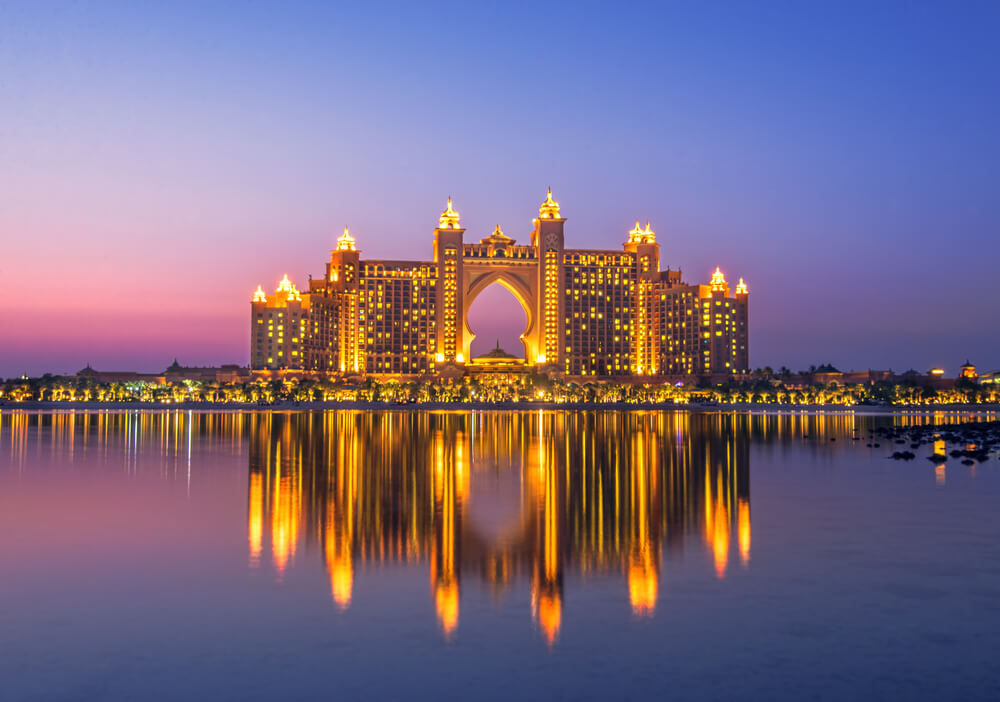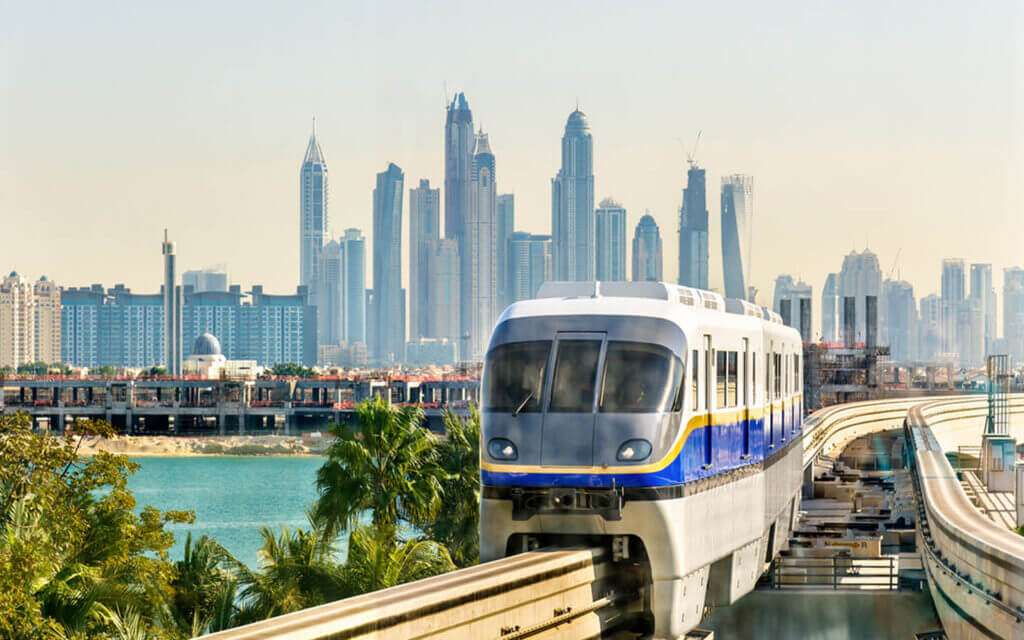The Palm Jumeirah island in Dubai is known to many as an architectural marvel. Its aerial view offers a stunning Palm tree-shaped impression of the man-made island. The enchanting island is also home to some of the world’s most luxurious hotels and resorts. This makes the perfect location for an impromptu weekend getaway to the United Arab Emirates, our article is sure to enthral you with some amazing facts about Palm Jumeirah.
Apart from being one of the most daring and successful architectural endeavours of the 21st Century, the view from the island is equally enchanting. The island is surrounded by an eleven-kilometre-long breakwater and protrudes almost five kilometres into the great Persian Gulf.
Whether your tickets are already booked, and the bags packed, or you are merely contemplating a possible vacation at this man-made miracle
Interesting Facts of Palm Jumeirah

Before we jump into the nitty-gritty of the Palm Jumeirah construction, infrastructure, architecture, cost of construction and such, let’s get to know some rather unknown and curious facts about Palm Jumeirah.
-
Satellites for Designing
We bet you didn’t know this interesting facts about Palm Jumeirah.
Palm Jumeirah, Dubai, is shaped like a date Palm tree when viewed from above. The Palm Jumeirah construction team employed a private satellite and Global Positioning System (GPS) to achieve this rare architectural feat. It is through the use of the satellite and GPS that the architects were able to uncover the exact coordinates for sand to be put to achieve the desired shape.
-
The Only Completed Island in the Trio
Palm Jumeirah, Dubai, is part of a larger architectural project that includes two other man-made islands, Deira Islands and Palm Jebel Ali. However, the other two projects are yet to be completed. This is primarily due to the great financial crisis of 2008, which affected the United Arab Emirates as well.
-
Tourism as the Saviour
At present, Dubai is one of the world’s most desirable tourist locations. However, this wasn’t always the case. The transformation of Dubai from the land of expatriates to a tourist hotspot can be attributed to a slew of carefully devised projects. These include Burj Khalifa, Palm Jumeirah and most recently, the Museum of the Future. This was a long-term plan to replenish UAE’s waning oil reserve funds.
Historical Facts of Palm Jumeirah
The man-made islands project construction in Dubai officially started in 1993. This structure later became home to Burj Al Arab Tour, famously known as the most luxurious and the only seven-star hotel in the world. However, the Palm Jumeirah construction did not start until 2001. The palm design for the islands was sketched out by the ruler of Dubai, Sheikh Mohammed bin Rashid Al Maktoum.
Infrastructure Facts Under Palm Jumeirah
Originally, Palm Jumeirah was intended to house 4,500 properties; this included 22 hotels, resorts, shopping malls and an extensive road network. In 2006, around 500 families had already occupied the residential properties. About 28 hotels were completed in another two years and became functional in Palm Jumeirah.
-
Atlantis The Palm, Dubai

Palm Jumeirah is famously known for the luxury resort Atlantis The Palm Dubai, located at the top of the 5.72 square kilometres long man-made island. The resort is known for alluring tourist attractions such as the Lost Chambers Aquarium, Aquaventure Water Park in Dubai, Ossiano restaurant etc.
Facts About Palm Jumeirah Construction
The Palm Jumeirah construction was as laborious as it was ambitious. Nakheel properties, a real estate company owned by the Dubai Government, was selected as the official developer of Palm Jumeirah. The plan was developed by an American architectural firm named Helman Hurley Charvat Peacock.
Three years after the commencement of construction, rudimentary infrastructure was already in place. Sand extracted from the Persian gulf floor was used to construct the islets.
During the Palm Jumeirah construction, Vibro-compaction technology was employed to prepare the land for construction. The sand was covered with three layers of rock- the first one weighing one ton and the subsequent layers weighing six tons each. It took almost eight months to stabilize the island so the 12,000 construction workers could enter it.
Fun Facts About Palm Jumeirah
Let’s delve into some fun facts about Palm Jumeirah!
-
- Palm Jumeirah, Dubai, home to around 12,000 palm trees, was built in just six years.
- Initially, there was a plan to build a 60-storey hotel by Donald Trump in Palm Jumeirah. However, the project was later shelved due to the global recession.
- During construction, a dam was built, and 5.5 million cubic meters of seawater was drained.
- Seven million tons of rock were used to lay the foundation of Palm Jumeirah.
Safety Facts of Palm Jumeirah
Let’s examine some Palm Jumeirah facts about the island’s safety.
To sustain the man-made island, a breakwater was constructed with a height of 3 metres and length of 11.5km, securing the island. The breakwater is crescent-shaped and shields Palm Jumeirah from the Shamal winds that cross the Persian Gulf. On either side of the breakwater is a 100m wide opening that facilitates water circulation and averts stagnation.
Prior to the Palm Jumeirah construction, critical variables such as the strength of sea storms and the potential rise in water level due to global warming were calculated.
Regardless of the above preventive measures, the engineers were wary of high tides that could impede their plans. However, at a width of 160 km and depth of 30 metres, the Arabian Gulf area was deemed safe from the tidal onslaught.
Architecture Facts Under Palm Jumeirah
The total land area of Palm Jumeirah is over 1,380 acres, making it one of the largest artificial islands globally. The entire island is in the shape of a date Palm tree, and a breakwater surrounds the structure in the form of a crescent.
Palm Jumeirah, Dubai, consists of 17 “fronds” stemming from the Palm tree structure. These fronds consist of resorts, luxury villas and other popular tourist attractions. Tourists can explore hotels and luxury stores in the Palm tree structure’s back.
-
Building Cost of Palm Jumeirah

The Palm Jumeirah construction structure alone cost USD 12 billion, excluding the cost of the residential apartments, resorts and other tourist attractions. Despite the mammoth investment endured, it is said that Palm Jumeirah, Dubai, has proved to be a lucrative investment since property prices are currently on the rise. Palm Jumeirah has also managed to draw in international crowds and become one of the most loved tourist attractions in the world.
Public Transportation Facts About Palm Jumeirah
Apart from the stunning architectural marvels of Dubai, its efficient public transport system often stuns tourists visiting the city. If you are planning to visit Palm Jumeirah, you can easily get there via bus, metro, tram or monorail.
-
Monorail
Opened in 2009, the transit monorail connects mainland Dubai to the crescent and runs about 4.8 km through the structure’s spine and trunk. Through the monorail, you can travel from the entrance of the Palm Jumeirah, Dubai, to the Atlantis at the top in just 10 minutes.
-
Metro

Though there isn’t a metro station at Palm Jumeirah, the nearest metro stations are Dubai Internet City and Nakheel. If you wish to travel by metro, you can board one at any of these stations and then catch a taxi to Palm Jumeirah.
-
Dubai Tram
Tram has now evolved as one of the most preferred public transport systems in Palm Jumeirah. It connects Palm Jumeirah to areas such as the Dubai Marina, Jumeirah Beach Residence and the Dubai Marina.
-
Bus
If you wish to travel to places such as the Jumeirah beach, you can board a bus, accessible through the Nol card.
Other Interesting Facts of Palm Jumeirah
Let’s take a look at some lesser-known facts about Palm Jumeirah
-
- Palm Jumeirah has increased the Dubai shoreline by almost 166% by adding 120 km.
- The Palm Jumeirah, Dubai’s meticulous architecture, has made it one of the few structures on earth that can be viewed from space.
- Almost 20,000 people use the monorail connecting Palm Jumeirah to mainland Dubai daily.
- Globally famous personalities such as Sharukh Khan and David Beckham own properties in Palm Jumeirah.
Conclusion
If you are looking for an interesting weekend getaway spot, Palm Jumeirah could be perfect for you. From indulging in a pampering session at the ultra-luxe Atlantis to taking a calm evening stroll through the Broadwalk, Palm Jumeirah, Dubai, is the epitome of the ideal paradisal vacation.
More Useful Article For You :
| Experience at Luxury FIVE Palm Jumeirah | FIVE Palm Jumeirah Dubai |
| All About The Palm Jumeirah | The Palm Jumeirah |
| Pros & Cons of Living in Dubai Marina | Living in Dubai Marina |
Frequently Asked Question (FAQs)
Palm Jumeirah is one of the largest man-made islands in the world, situated in the Arabian Gulf.
The man-made island is shaped like a Date Palm tree and surrounded by a crescent-shaped breakwater; therefore, it is called Palm Jumeirah.
Despite being an architectural marvel, Palm Jumeirah, Dubai, has several tourist attractions such as luxury hotels, aquariums and resorts.
One of the most interesting Palm Jumeirah facts is that it was initially built to attract tourism to the United Arab Emirates in the face of depleting oil reserves.
Yes, Palm Jumeirah, Dubai, is one of the few man-made structures on earth than can be viewed from space. This is one of the most curious Palm Jumeirah facts on the list.
Yes, Palm Jumeirah, Dubai, is man-made and developed by the Dubai government-owned company Nakheel. What is special about Palm Jumeirah?
Why is it called the Palm Jumeirah?
Why do people visit Palm Jumeirah?
Why was Palm Jumeirah built?
Can Palm Jumeirah be seen from space?
Is the Palm Jumeirah man-made?




